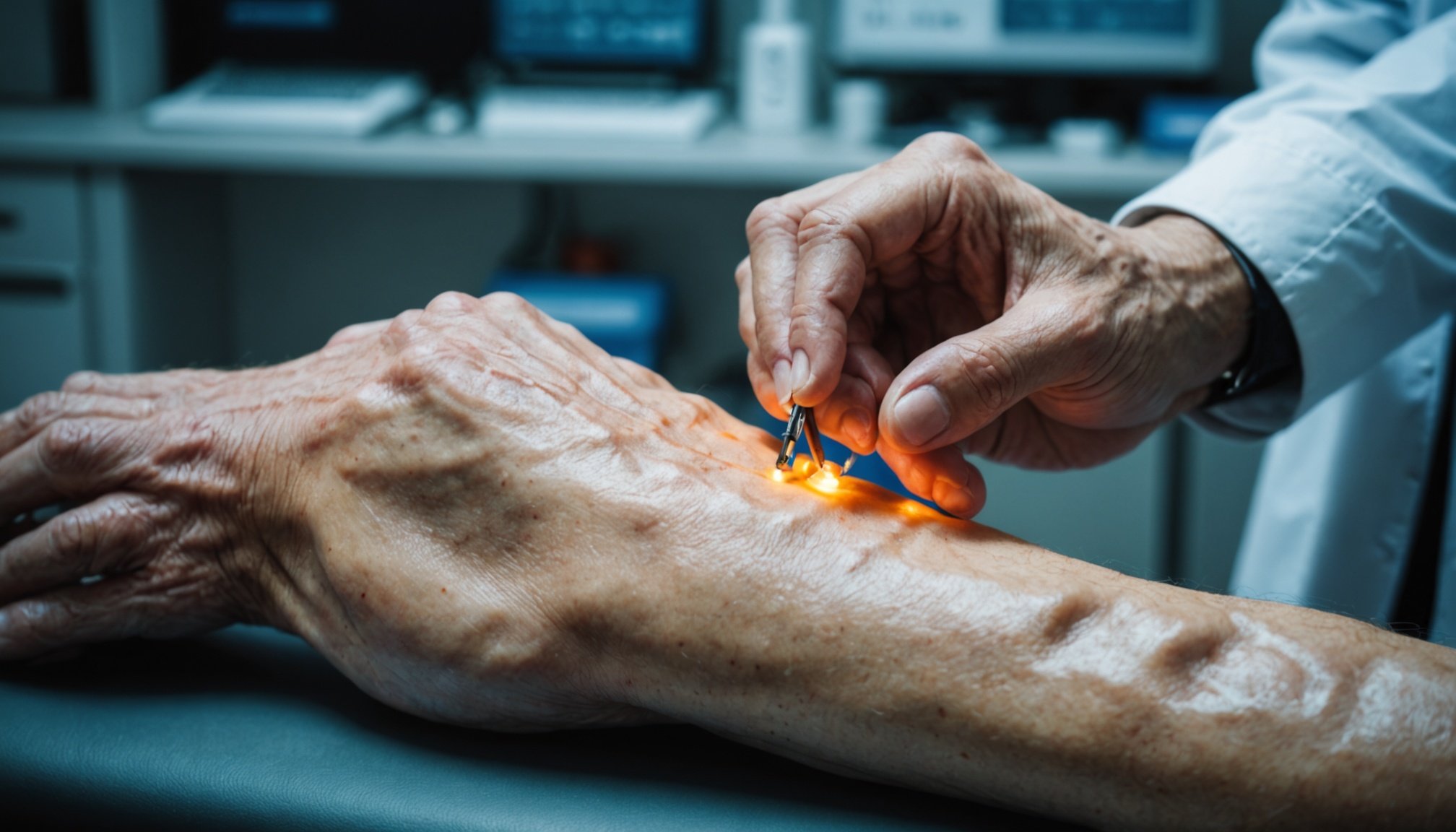Unlocking Cutting-Edge Approaches: How UK Pain Experts Tackle Neuropathic Pain Without Opioids
The Growing Need for Non-Opioid Pain Management
In the UK, as in many other parts of the world, the management of neuropathic pain has become a critical health issue. With the opioid crisis looming large, healthcare professionals are scrambling to find effective, non-addictive alternatives to manage chronic and acute pain. Neuropathic pain, in particular, poses a significant challenge due to its complex nature, often resulting from damage to the nervous system.
Neuropathic pain affects a substantial number of people, with estimates suggesting that it impacts around 8% of the general population. This condition can manifest in various forms, such as diabetic neuropathy, postherpetic neuralgia, and chronic back pain, among others. The traditional reliance on opioids has led to a plethora of problems, including addiction, overdose, and a range of debilitating side effects.
In the same genre : Proven tactics for uk optometrists to tackle the surge of digital eye strain in young adults
Innovative Therapies: Photobiomodulation (PBM) Therapy
One of the innovative approaches gaining traction in the UK is Photobiomodulation (PBM) therapy. A recent clinical trial conducted by the Department of Pain Management at the Sandwell and West Birmingham NHS Foundation Trust has shown promising results in treating fibromyalgia, a condition characterized by widespread neuropathic pain.
How PBM Therapy Works
PBM therapy involves the use of low-level laser or light-emitting diodes to stimulate cellular processes, promoting tissue repair and reducing pain. In the trial, patients underwent treatment using the NovoTHOR Whole Body PBM Therapy Light Bed. Here are some key findings:
In parallel : Revolutionizing peritoneal dialysis: insights from top uk nephrologists on cutting-edge approaches
- Pain Reduction: Pain levels decreased by 44% after six weeks of treatment, with significant improvements in the Manual Tender Point Survey (MTPS) scores[2].
- Quality of Life: Quality of life scores improved by 31% at six weeks, as measured by the Revised Fibromyalgia Impact Questionnaire (FIQR)[2].
- Other Benefits: Fatigue, sleep quality, anxiety, and depression scores all showed significant improvements. For instance, sleep quality improved by 34%, and anxiety and depression scores dropped by 34%[2].
Patient Outcomes and Long-Term Effects
The study demonstrated that these improvements were not transient. Even 24 weeks after the last treatment, patients maintained a 19% improvement in their FIQR scores, indicating a lasting positive impact on their health.
| Measure | Baseline | 6 Weeks | 24 Weeks |
|
|-----------|
|----------|
| FIQR Score | 79.7 | 55.3 | 65 |
| Pain Levels | 7.08 | 3.93 |
|
| Fatigue | 6.3 | 5.6 |
|
| Sleep Quality | 17.4 | 11.5 |
|
| Anxiety and Depression| 12.5 | 8.21 |
|
New Chemical Entities: XG005 and Suzetrigine
In addition to PBM therapy, pharmaceutical companies are developing new chemical entities that target pain pathways without the use of opioids.
XG005: A Dual-Action Analgesic
Xgene Pharmaceutical has introduced XG005, a non-opioid, multimodal analgesic that targets both nociceptive and neuropathic pain signals. In a Phase 2b clinical trial involving patients undergoing bunionectomy, XG005 demonstrated significant efficacy:
- Pain Intensity: The high dose of XG005 resulted in mild pain severity, compared to severe pain in the placebo group. The pain intensity score was statistically lower in both active arms over 72 hours post-surgery[1].
- Rescue Medication: The time to first use of rescue medication was delayed up to 8-fold in the high dose arm, and total opioid consumption was significantly less in the active arms[1].
- Patient Global Assessment: Patients reported better pain control and improved sleep quality in the XG005-treated arms[1].
Suzetrigine: A Selective NaV1.8 Inhibitor
Vertex Pharmaceuticals is developing suzetrigine, a highly selective NaV1.8 pain signal inhibitor. In a Phase 2 study for the treatment of painful lumbosacral radiculopathy, suzetrigine showed promising results:
- Pain Reduction: Suzetrigine resulted in a statistically significant and clinically meaningful reduction in pain intensity, with a mean change in the Numeric Pain Rating Scale (NPRS) of -2.02 at Week 12[4].
- Safety Profile: Suzetrigine was well tolerated, with no serious adverse events related to the treatment. The incidence of adverse events was lower in the suzetrigine arm compared to the placebo arm[4].
Clinical Research and Data-Driven Approaches
Clinical research plays a pivotal role in the development of new pain management strategies. Here are some key aspects of how data and research are driving these innovations:
Rigorous Clinical Trials
Both the PBM therapy trial and the XG005 and suzetrigine studies were conducted through rigorous clinical trials. These trials involved multiple centers, placebo controls, and large patient populations to ensure the reliability and generalizability of the results.
Patient-Centered Outcomes
The focus on patient-centered outcomes is crucial. For example, the Revised Fibromyalgia Impact Questionnaire (FIQR) and the Numeric Pain Rating Scale (NPRS) provide comprehensive insights into how treatments impact patients’ daily lives and overall well-being.
Collaboration and Funding
Collaboration between healthcare providers, research institutions, and pharmaceutical companies is essential for advancing pain research. Funding from both public and private sources is critical for supporting these efforts.
Mental Health and Chronic Pain
Chronic pain is often intertwined with mental health issues, such as depression and anxiety. Effective pain management must consider the mental health of patients.
The Brain-Pain Connection
The brain plays a central role in processing pain signals. Chronic pain can lead to changes in brain structure and function, exacerbating mental health issues. Treatments like PBM therapy and new chemical entities aim to address these complex interactions.
Holistic Care Approaches
Holistic care approaches that include pain education, psychological support, and lifestyle changes are becoming increasingly important. For instance, cognitive-behavioral therapy (CBT) can help patients manage their pain and improve their mental health.
Practical Insights and Actionable Advice
For individuals suffering from neuropathic pain, here are some practical insights and actionable advice:
Seek Multidisciplinary Care
- Interdisciplinary Teams: Work with healthcare teams that include pain specialists, physical therapists, psychologists, and other professionals to get a comprehensive treatment plan.
Explore Alternative Therapies
- PBM Therapy: Consider PBM therapy, especially if you have conditions like fibromyalgia.
- New Medications: Discuss new non-opioid medications like XG005 and suzetrigine with your healthcare provider.
Focus on Mental Health
- Mental Health Support: Do not neglect your mental health. Seek support from psychologists or therapists to manage stress, anxiety, and depression.
- Lifestyle Changes: Make lifestyle changes such as regular exercise, healthy diet, and adequate sleep to help manage chronic pain.
Stay Informed
- Stay Updated: Keep abreast of the latest research and clinical trials in pain management.
- Patient Education: Educate yourself about your condition and the available treatment options.
The management of neuropathic pain is a complex and multifaceted challenge, but UK pain experts are making significant strides through innovative therapies and rigorous clinical research. As we move forward, it is clear that a combination of cutting-edge treatments like PBM therapy and new chemical entities, along with a holistic approach to care, will be crucial in providing effective and safe pain management for patients.
In the words of Leon Jiang, Chief Medical Officer at Xgene Pharmaceutical, “There is a substantial need for more efficacious, safer, non-opioid treatment for acute pain… We are pleased that the results from this trial showed the excellent therapeutic effect of XG005, with the potential to be a better treatment option compared to current therapies.”[1]
As we continue to unlock new approaches to pain management, it is essential to remember that every little bit counts, and the collective efforts of researchers, healthcare providers, and patients themselves will pave the way for a future where chronic pain is managed effectively and safely.











